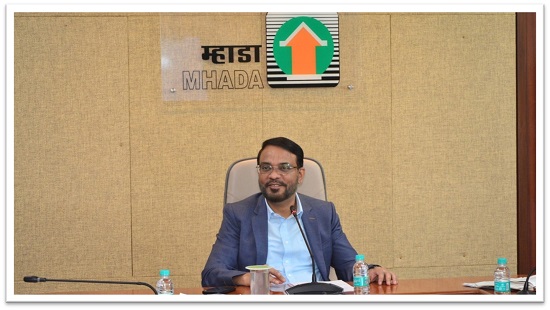
Mumbai’s Housing Revolution, Redevelopment and Cluster Projects Changing Lives - Insights from MATA Samvad
The recently concluded MTA Samvad by Maharashtra Times offered valuable insights into Mumbai’s redevelopment projects and the city’s real estate growth. IAS Sanjeev Jaiswal, vice president and CEO of MHADA, highlighted the transformative impact of the authority’s redevelopment initiatives. He emphasized how strategic planning, innovative housing models, and a people-centric approach are reshaping Mumbai’s real estate landscape. Under his leadership, MHADA has combined large-scale modernization with community welfare and sustainable planning, replacing aging structures with high-rises and creating neighbourhoods integrated with schools, hospitals, gardens, and recreational spaces. By focusing on such strategic, people-centric housing models, these efforts are providing homes to thousands, improving infrastructure and connectivity, and redefining what it means to build a modern, livable Mumbai.
Mumbai, often called the financial capital of India, has long struggled with a growing population, rising real estate costs, and the challenge of providing affordable housing to its residents. Decades-old buildings and chawls have become symbols of the city’s housing crisis, with many families living in cramped, outdated tenements. In such a scenario, meaningful urban redevelopment and affordable housing initiatives are not just important—they are crucial for the city’s social and economic future.
BDD Chawl Redevelopment: A Model for the Future
The BDD Chawl redevelopment project stands as a landmark urban renewal initiative. Decades-old housing structures are being replaced with modern high-rises, and the first-phase beneficiaries have already received keys to their new homes. The upcoming phases in Nilganga and N.M. Joshi localities are expected to follow soon, while approvals for land transfer at Sewri are anticipated shortly.
The project aims to ensure that by 2029, approximately 15,500 units are handed over to beneficiaries, turning the dream of homeownership into reality for many. Its cluster redevelopment model goes beyond replacing old buildings—it integrates schools, hospitals, gardens, and recreational spaces to create holistic neighbourhoods. Similar initiatives, such as Patra Chawl in Goregaon, demonstrate how original residents benefit from larger, modern homes without additional costs.
Cluster Redevelopment: Revamping Entire Neighbourhoods
Mumbai is experiencing a surge in cluster redevelopment projects, covering nearly 1,000 acres across the city. These initiatives rehabilitate original residents while adding new housing stock, open spaces, and modern amenities. Residents of smaller tenements often receive significantly larger units at no extra cost, supported by reputed developers ensuring efficient project execution.
Despite being one of the most expensive cities in India, with an affordability index of 51%, strategic planning under Sanjeev Jaiswal’s guidance aims to bring this closer to global standards of 30%, making housing more accessible for middle-class families.
Expanding Housing Access Across Mumbai
The city’s growth is driven not just by real estate, but by the need to retain professionals and maintain Mumbai as the country’s economic hub. Redevelopment projects in Charkop, Mahim, Prabhadevi, and Dadar focus on reviving ceased buildings and PMGP structures, providing additional housing and improving urban infrastructure.
Transportation and connectivity enhancements—such as the Coastal Road, Aat Setu, Metro expansions, and Navi Mumbai International Airport—have significantly reduced commute times. Travel from Kala Nagar or BKC to Churchgate now takes just 20–25 minutes, increasing the desirability of residential projects and contributing to sustained economic growth.
Realizing Realty Dreams
Under IAS Sanjeev Jaiswal’s leadership, Mumbai’s housing landscape is evolving with a focus on accessibility, sustainability, and community living. The MATA Samvad event highlighted the city’s ongoing redevelopment efforts, showcasing how strategic planning and integrated development are turning housing dreams into reality for thousands of Mumbaikars.
Mumbai is not just building homes—it is building thriving, inclusive neighbourhoods, setting a benchmark for urban redevelopment across India.

